|
ANIMAL SLIDES:
<Researchers><Development> <Equipment> |
|
|
|
TEST DATA |
|
1

<Previous>
<Full
size>
<Next>
Tests of peak shapes, resolution, and abundance
sensitivity for the 10 cm radius mass spectrometer in ANIMAL:
a)
Scan of 40Ar for air from an air pipette (amplitude=volts, DAC is
the magnet control setting for the scan);
b) scan of 36Ar in the
same air shot; c) resolution is ~ 130, as measured for this scan
across the range of 40Ar and 39Ar (for a sample aliquot derived by
fusion of one Fish Canyon sanidine crystal from NMT-FC2); d)
abundance sensitivity is < 30 ppm, as determined for this scan
across the range of 40Ar to 39Ar, where the
40/39 ratio is ~ 300.
|
|
td1 |
|
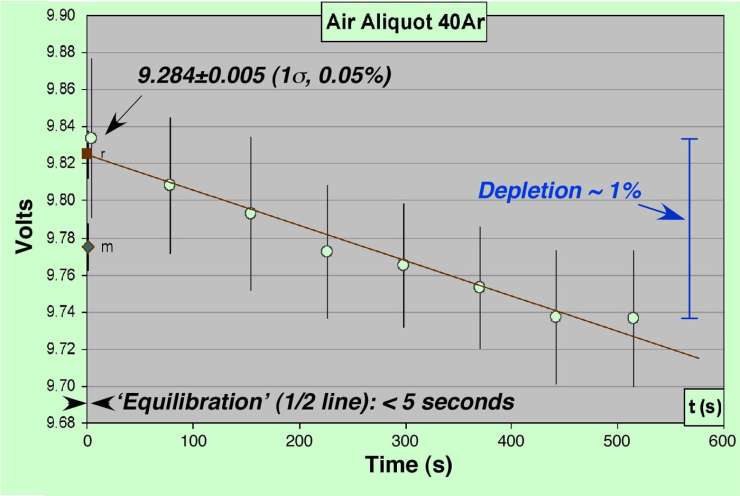
<Previous>
<Full
size>
<Next>
Picture 40Ar measurements (over eight cycles) for analysis of one half-split of an air aliquot. The equilibration time for half of the line is less than 5 seconds, and a full sample equilibrates in less than 20 seconds.
|
|
11 |
|
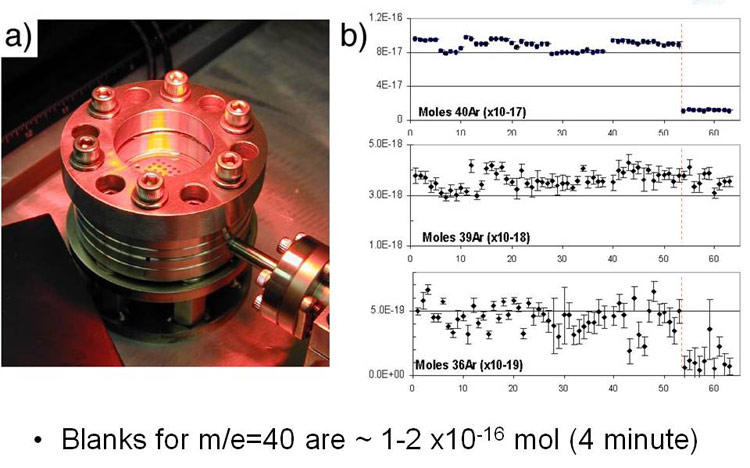
<Previous>
<Full
size>
<Next>
a: CO2 laser sample chamber during bakeout of samples with a heat lamp.
b: Full operational blanks for 40Ar, 39Ar, and 36 Ar (in moles, numbered 1-53) collected over a few days of analysis for sanidine crystals, as part of ANIMAL’s participation for the Earthtime test. Note that blanks 54-64 were obtained with the sample chamber ‘valved off.’ The lower 40Ar and 36Ar in the final blanks demonstrate a small amount of air diffusion for this single-seal window. Future CO2 laser sample chamber designs, perhaps with a double-vacuum seal, could permit 40Ar blanks in the 10-17 mol range for ANIMAL. Alternatively, use of a standard (visible- or UV-compatible) could yield mid-10-17 mol blanks for 40Ar on this system.
|
|
2 |

<Previous>
<Full
size>
<Next>
Air pipette ratios run in ANIMAL over a two week period (about three pipette analyses per day)
|
|
3 |
|
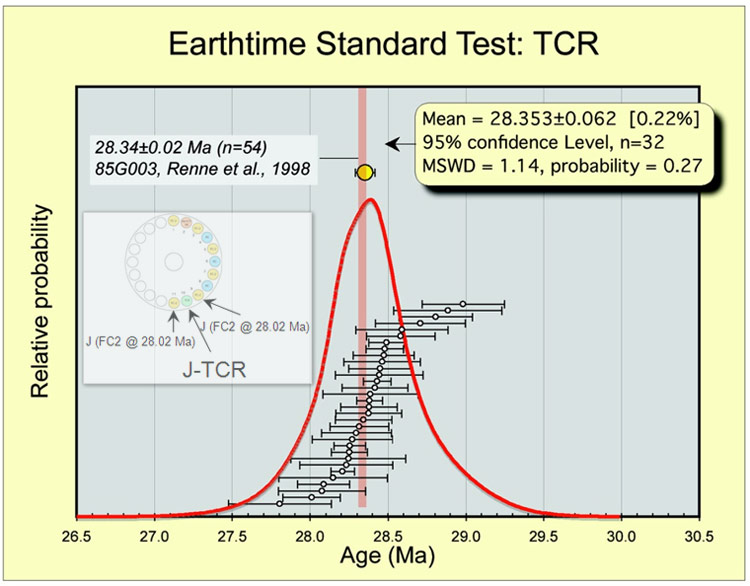
<Previous>
<Full
size>
<Next>
Age determinations of the Taylor Creek Rhyolite (TCR) standard (n=32), and a resulting probability distribution for the Earthtime test (samples distributed 11/08). The ages are relative to Fish Canyon sanidine at 28.02 Ma (the J-value was determined from analyses of NMT-FC2 sanidine, as indicated.). Also shown are the weighted mean (yellow symbol) and a prior result for TCR determined by Renne
et al. (1998), each at the 95% confidence level.
|
|
4 |
|
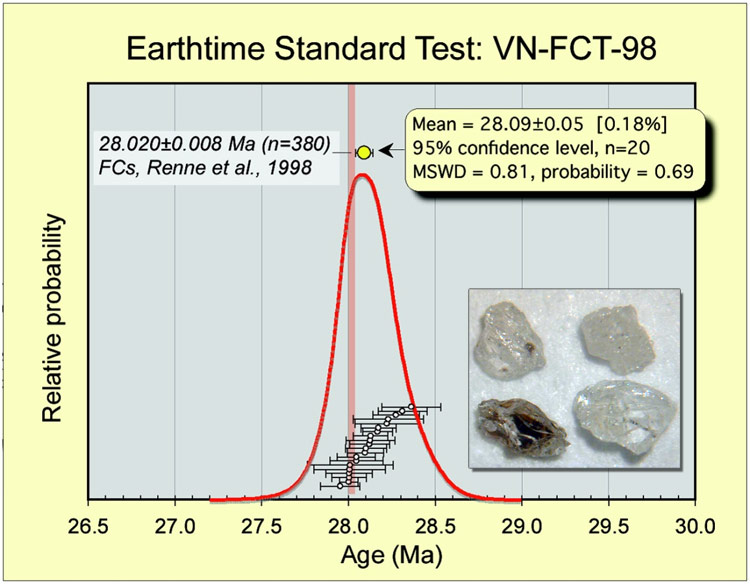
<Previous>
<Full
size>
<Next>
Age determinations of the Fish Canyon sanidine standard VN-FCT-98 (n=20), and a resulting probability distribution for the Earthtime test (samples distributed 11/08). The ages are relative to Fish Canyon sanidine at 28.02 Ma. Also shown are the weighted mean (yellow symbol), and a prior result for a different split of FCT determined by Renne et al. (1998), each at the 95% confidence level. Note that a few crystals of this standard with large melt inclusions (as in the photo, lower left) were excluded from analysis.
|
|
5 |
|
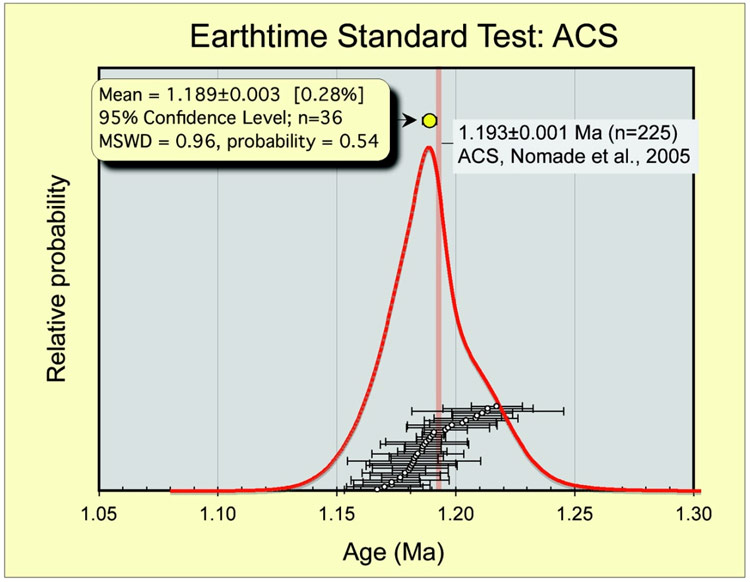
<Previous>
<Full
size>
<Next>
Age determinations of the Alder Creek sanidine standard ACS (n=36), and a resulting probability distribution for the Earthtime test (samples distributed 11/08). The ages are relative to Fish Canyon sanidine (NMT-FCT) at 28.02 Ma. Also shown are the weighted mean (yellow symbol), and a prior result for a different split of ACS determined by Nomade et al. (2005), each at the 95% confidence level. The ACS analyzed is from the same 440-850 micron size split as analyzed by Nomade et al., 2005.
|
|
6 |
|
Top of Page |

